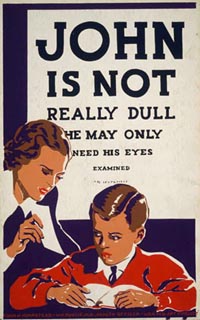memory
Posters from the WPA
Posters from the By the People, For the People: Posters from the WPA, 1936-1943. 908 posters from the collection of the Library of Congress. Read about the exhibit, check the massive subject listing, or skip straight to the highlights.
Selling Soap with Stereotypes
Trade cards are a “single piece of medium weight paper slightly smaller than a post card, printed with decorative images which directly or indirectly promote a commercial product, service, or event. Trade cards were used widely from the 1870s to the end of the 1890s, and were commonly distributed to the public at store counters, expositions, and through the mail.” The Daniel K.E. Ching Collection of the Chinese Historical Society of America has over four hundred trade cards produced in the United States and Europe that contain racist depictions of Chinese and Chinese Americans. Several images have been posted online. For a bit of context read the essay.
Found via American Samizdat.
Camo in the City
At the airport in New York, two beefy guys stand akimbo in full camoflague gear, semi-automatic weapons casually slung. How very funny to see them decked out in green jungle camouflage against the commercial white interior and cheap gray carpet. In fact, it’s pretty clear the camo gear is not to conceal, but to be unavoidably present. Like the machine guns which may or may not be loaded, it is a loud signifier of military-ness, a show of force, a warning and reminder of the presence of power.
Branding Beijing
“Beijing Organising Committee of the 2008 Olympic Games (BOCOG) opened a two-day Olympic Design Conference in Beijing on Tuesday in a bid to find the most appropriate ways to impress the world visually. Beijing Mayor Liu Qi said in the opening address that through the magnificent and unique ‘Olympic look’, Beijing will unfold the great charm of this global sporting event and the history of China. Meanwhile, Beijing will also ‘promote the concept of “New Beijing, Great Olympics”, and demonstrate and elevate the image of Beijing and China in the world’, added Liu, who is also BOCOG president.”
From the People’s Daily.
These Colors Don't Run
“The people in the apartment across the street have had an American flag hanging outside their second floor window since the day after 9/11. Looking out my window this morning, I noticed that the bottom of the flag is tattered from waving in the brisk San Francisco breeze for ten months. The top red stripe is seceding from the rest of the flag, the wind gradually tearing it away from the other twelve.
I wonder if they’ve forgotten about the flag and the reasons they bought it in the first place, the respect they must have felt for it then and the disrespect with which they are treating it now.”
From kottke.org.
Palestinian Poster Project
“Liberation Graphics began actively collecting Palestinian posters in 1974 and now houses what many experts believe to be the world’s largest and most comprehensive collection of Palestinian-published and Palestinian solidarity poster art.”
The Red Menace
Email from a friend in South Korea during the 2002 World Cup:
“The new national color of Korea is red. It used to be that red stands for communists in Korea and therefore, it’s a taboo color. We used to color communists in red in all the anti-North-Korean posters. When I was young, I even thought that communists had red faces. All of sudden, red became the color for Korean soccer, thanks to ‘Red Devil,’ the non-profit national soccer cheering association. The streets are filled with people wearing red T-shirts with ‘The Reds’ writing. I guess red is no longer a taboo.”
Posters of the Spanish Civil War
Posters of the Spanish Civil War from the University of San Diego Southworth Collection. Read the intro then skip right to the thumbnail index. See also drawings made by Spanish children during the war.
Moscow Underground
Some links about the “Diggers of the Underground Planet,” a group of urban adventurers exploring the tunnels beneath Moscow. Discoveries include a 3,000 seat bunker under a cathedral, deserted chemical warfare labs, ancient stashes of skulls, alternative housing, a ring of metro stations never used by the public, and possibly a mass grave from the Stalin era.
Found via Metafilter.
The Commissar Vanishes
“Photographs can lie. They certainly do in the Soviet Union from 1929 to 1953, the years of Joseph Stalin’s dictatorial rule. Stalin’s agents routinely arrest and kill as ‘enemies of the people’ anyone who disagrees with his politics. Communist Party workers then try to remove any trace of these people from the photographic archives, and so from the media. The Commissar Vanishes exhibition explores this censored history.”
Found via American Samizdat.


